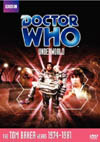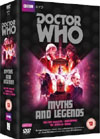DVD Extras include:
The Importance of Charismatic, Skilled Explorers in Sci-fiThe good TARDIS interior gets its due in the first and last episode, as has been the case in every story this season since its debut in "The Invisible Enemy" (story no. 93). But a new bad legacy is beginning to take shape: This is the third story in a row to skimp on proper visuals for both the arrival and departure of the police box exterior. Not good.The dialogue starts to noticeably fall apart on this very subject, as the Minyan crew is introduced on the bridge of their ship while the sound of a disappointingly off-screen TARDIS materialization quietly wafts in from another compartment. The crewmembers are all busy staring at their monitors and instruments, and begin talking about a mysterious "it". And so the confusing dialogue begins to flow. Just what is this undescribed "it" that they are so keen to investigate? The audience is left to wonder what they're talking about for several beats, in addition to the questions of who they are and what they're all about. Finally Captain Jackson gains enough wit to ask to HEAR "it" again, the first indication that they have been talking about a sound. The script could have fixed this with dialogue like "What was that sound?" instead of "What was it?". Failing that, the director could have fixed it by having the actors lift their heads, cock their ears, and respond to the sound of the TARDIS materializing off-screen, but that doesn't happen either and several beats of confusion are the end result. It appears that no one on the production is paying attention to what they're doing. If only that were the only instance of that sort of thing, but excruciatingly bad dialogue pops up all through the rest of the story. It seems to be largely a function of character. The Doctor is about the only character who comes across well, largely because Baker and Martin allow him to completely adapt to any situation, understand it, and articulate an explanation for it that is both complete and entertaining. Most other characters are shown to be limited to understanding the things that they are already familiar with, and even then they often have trouble expressing themselves. For the most part, these characters are not properly skilled to explore the sort of high-end sci-fi concepts that Baker and Martin want to write about. In the end, the characters are left to utter clumsy gags and gimmicks whenever they try to wrap their minds around something new, and the humour falls flat here and rarely works. Today's catch-phrase crutch is "The quest is the quest." Easily the dullest of the three that Baker and Martin have come up with during their last few stories. Once more, Leela seems to get the worst of the treatment, with constant references to her being primitive, and not smart enough, and super-keen to fight any battle for any reason. And on top of that, we see her feeling more freedom to flip switches on the Doctor's well-guarded TARDIS console than any other companion before her. The paradox is astoundingly unbelievable. When problems arise in the TARDIS's flight, the natural assumption is that she had something to do with it, even though hindsight suggests that the story hadn't actually intended to give that impression. Leela does at least get a good emotional scene early on, accusing everyone else of laughing at her. The production team might have made more progress with her character arc in the long-term if they had done more with this kind of confrontation, and showcased more of her perceptiveness and too-often-overlooked adaptability. The questing Minyan crew manage to stand out a bit amongst the guests, as does Norman Tipton's character Idas. Pretty much all of the other characters are easily forgettable, having little screen-time and few close-ups. The story's "villains" lack presence more than any other on Doctor Who for some time. By the time the credits roll, half of the character names have still not made enough of an impression to be recognizable.
Virtual Set ExperimentationOf course, the big cost-saving experiment on this production is to have small cavern models keyed into the background to avoid having to build any full-scale cavern sets. This does give the cavern scenes a strange look, but then it is a new type of environment - so who is to say it shouldn't look the way it does? What is most noticeable is the restriction on camera movement. Although a very successful left-to-right pan is achieved near the end of episode two, the camera remains rigidly frozen during most shots to ensure that model and live-action elements line up as best as possible, which limits visual artistic expression somewhat. A lot of intercutting happens instead, occasionally not getting required ideas across, but being successful most of the time.Is this a good template for the future? Well, considering that the biggest problem on most Doctor Who productions is not so much money as it is time, and quite often studio time specifically, the time-consuming lining up of shots probably isn't as efficient as just having a decent set to start with. That said, models CSO'd in always have their place in the wide-angle establishing shots. I like the general impression of size that these tunnels in the planetoid have, but a lot of the close-ups and dialogue scenes might have worked just as well with a real and smaller set, and allowed more of a focus on performance.
Beam me up, Mitch!A lot of care and passion must have gone into the laser beams superimposed onto the picture during fire fights. These are amongst the very elite best effects the classic program has ever boasted. Visual beams glowing in several colours, seen clearly exiting the weapon accurately, moving across the frame, and impacting the target. Even when too much begins to happen at once in later scenes, and some firings are limited to glowing target-impact diamonds only, the quality of the beam effects remains consistently high overall. If anything at all could be improved, perhaps the movement in some firings should be faster, and perhaps the sound effect could be deeper and/or contain more power. But this story really can be proud of its laser effects.One of the story's sore points is the old ritualistic cult formula that rears its ugly head in the second half of the story. This is a bore as usual, and very little has been done to make this week's version of it anything special in terms of character or plot or style. The staple process of the Doctor Who series known as "regeneration" is demonstrated exceptionally well in this story, with its background being narrated, while supporting visuals of the process appear on screen. Dudley Simpson puts in his most atmospheric piece of music for the story during this moment, making it one of the best of the entire tale. Regeneration is well-motivated here also, successfully combatting old age and staving off death indefinitely.
This story is currently available on VHS video, and coming to DVD:
Comments on this article are welcome. You may contact the author from this page:
|








